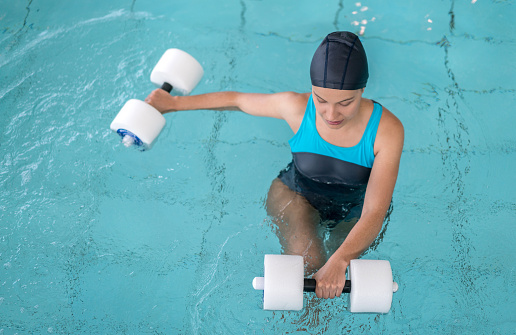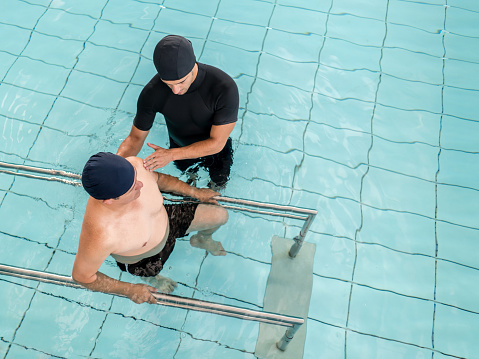Pool therapy is a great way to exercise and have fun at the same time. It’s also known as aquatic physical therapy, and can help with various injuries and health problems.
Whether you’re looking for some relief from pain or want to keep your body healthy, pool therapy might be just what you need. This blog post will go over why it’s good for so many things and how it works.
Is Pool Therapy a Form of Physical Therapy?
Aquatic or pool therapy is a form of physical rehabilitation that takes place in pools or other aquatic environments. A range of terms is used to describe aquatic therapy, including water therapy, aquatic rehabilitation, hydrotherapy, aqua therapy, therapeutic aquatic exercise, and pool therapy.
Who Needs Pool Therapy?
If you’re suffering from chronic or acute pain, then aquatic therapy may be something for which is worth considering. Spending time by a therapeutic pool can help alleviate many of these injuries and ailments, including:
- Stroke
- Muscle spasms
- Car accident injuries
- Muscle weakness causing loss of balance
- Joint pain and back pain
- Diabetic Peripheral Neuropathy
- Heart disease
- Sports injury
- Circulation problems
- Traumatic brain injury
- Arthritis
- Neurological injury

How Can Pool Therapy Help Patients Suffering from the Above Conditions?
Patients Benefit from Increased Joint Flexibility
Aquatic therapy is an excellent way to increase joint flexibility. Buoyancy allows for an increased range of motion, and warm water can help relax sore or tight muscles. The movement, therefore, becomes less painful.
Improved Balance, Coordination, and Stability
Aquatic therapy helps to improve balance and coordination by providing support for your body’s alignment. When you are in the water, it feels as if gravity has been pushed away.
Weightlessness allows for a sense of freedom while forcing your body into an upright position so that you can move without fear of falling or hurting.
Reducing Symptoms of a Neurological Injury
Water is the perfect therapy for people who have experienced neurological damage, as it can help decrease abnormal tone and spasticity. Water temperatures over 92 degrees and massage reduce the tone caused by the injury, making it easier for your body’s system to heal itself.
Pain Relief
Aquatic therapy is a natural way to improve your comfort and relieve pain. The warm water immersion increases blood supply, which relieves sore muscles while promoting relaxation for those who experience discomfort from their condition or suffer from injuries in general. Weight reduction of weakened body structures also creates an additional level of relief.
Build Muscle Strength
Aquatic therapy is a great way to get in shape and build muscle strength. The resistance offered by water, which is much higher than that of air, makes it easier for your body to strengthen weakened muscles.
Cardiovascular Benefits
The benefits of aquatic therapy are endless, but one significant way it helps with your cardiovascular system is hydrostatic pressure. Hydrostatic pressure increases the workload on the heart and lungs.
Hydro-pressure exercises can increase your core strength and improve muscle mass and agility, which will help with everyday life activities like walking up the stairs.
Rebuilds Muscle Memory
Swimming in a pool of water has always been one way people have found peace and tranquility- but it turns out that this wasn’t just down to their imagination. When you move through water, its viscosity and resistance make it a challenge to do anything fast. Because of this, your brain gets to process signals thoroughly, and this provides an excellent advantage of restoring muscle memory.
Why is Pool Therapy Better Than Any Other Type of Physical Therapy
No Expensive Equipment
Aquatic therapy is the only type of physical therapy that does not require expensive equipment. You need a pool and life jacket, but other than those two things, aquatic exercises are just as effective.

It’s Almost Effortless
Aquatic therapy is better than any other type of physical therapy because you don’t need to use a lot of effort or energy but still get all the same benefits from working out.
You don’t need a lot of effort or time to get stronger, more agile, and relieve pain; plus, there’s less risk for injury.
Great for People of All Ages
In addition to being an effective form of treatment, aquatic therapy is for all. It can be done by kids, but it’s especially beneficial to seniors since they often have more difficulty with other types of rehabilitation exercises due to their age or disability preventing them from doing traditional forms of PT.
What are the Limitations of Pool Therapy?
- Due to the buoyancy in the water, walking feels more effortless, but after leaving the pool, you may still have difficulty achieving balance and control since there is no resistance on land.
- People suffering from cardiac diseases, bladder/bowel incontinence, and infections can not go through with this form of therapy
- It’s only limited to people who can swim
Common Aquatic Therapy Exercises
1. Ai Chi
Ai Chi is an ancient form of water therapy that combines elements from tai chi and qigong. The exercises combine progressive resistance training and diaphragmatic breathing and while integrating spiritual, physical, and mental energy to relax the body through meditation-like movements in shoulder-deep waters.
This type has long been used by seniors to improve balance, given its focus on lateral stability.
2. Aqua Running/ Aqua Jogging/ Underwater Running
Aquatic jogging is a great way to get your heart rate up while avoiding intense impact. The water provides cushioning and shock absorption, so you don’t have to worry about injury. For injured people or those who prefer low-impact workouts, aqua running can be the perfect form of exercise.

Aqua jogging is also one of the easiest ways to lose weight, especially for overweight people. Though it’s slower than running on dry land, the pressure from the water makes this easier for your heart rate and intensity level while burning more calories per minute.
3. Watsu
The Watsu is a type of aquatic therapy that combines various elements such as dance, massage, muscle stretching, shiatsu, and joint mobilization to help relieve stress and tension.
Watsu therapists support their patients through these exercises in addition to treating orthopedic conditions or neurological impairments with complementary land-based treatments programs.
4. Burdenko Method
The Burdenko Method is a form of therapy that improves the patient’s speed, strength, endurance, flexibility, balance, and coordination. It’s often used for treating sports-related injuries by integrating land and water approaches into one technique.
Conclusion
Pool therapy is great for so many things. It can improve balance, offer pain relief and help rebuild muscle memory. Pool therapy offers cardiovascular benefits as well as builds muscle strength. This type of rehabilitation is also good for people who are just getting back into exercise or those with injuries that need to be rehabilitated in a controlled environment.
